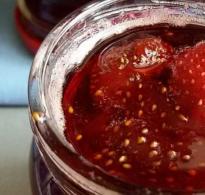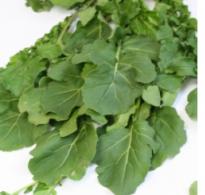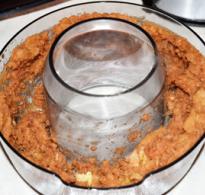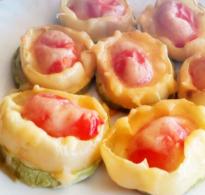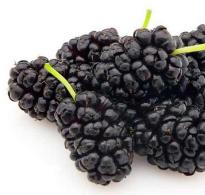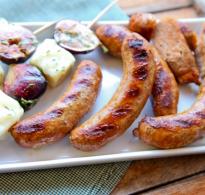Recipe for seedless plum jam. Pitted plum jam
Plum is a fruit that is created in order to make jam from it. It turns out incredibly aromatic and tasty. Any jam is a sweet dessert, but I put less sugar in plum jam, and besides, it is rich in pectin, which for its cleansing properties has been called “the human body’s orderly.” Once inside, pectin absorbs harmful substances and removes them, which allows internal organs to work better. Here I will talk about which variety to choose for jam, how to make plum jam and jam, and how these desserts differ from each other. And of course, don’t forget that plum jam, thanks to its thickness, aroma and pleasant sourness, is one of the best fillings for pies and cookies.
You will need:
- plum 1 kg
- sugar 700 gr
First, let's define the terms.
Jam- a traditional dessert among the Eastern Slavs - Russians, Ukrainians and Belarusians, as well as the peoples of Transcaucasia and some other, mainly eastern peoples. It is obtained by cooking or , less often , young walnuts, young pine cones, , with sugar for the purpose of canning. In the right jam, pieces of fruit or berries remain intact, completely soaked in thick syrup and immersed in it. For jam it is better to use slightly unripe fruits.
Jam- a dessert obtained by boiling fruit or berry puree with or without sugar. This is a thick, homogeneous mass, without inclusions of fruits or berries. For jam it is better to use overripe fruits and berries with a high pectin content.: apples, pears, plums, gooseberries.
And, for completeness of knowledge, let’s define one more concept - this Jam or Confiture- a jelly-like food product with whole or crushed fruits (berries) evenly distributed in it, boiled with sugar with the addition of gelling agents (usually pectin or agar-agar). Aromatic spices are often added to this dessert: cloves, cinnamon, star anise, allspice. Jams and confitures are a favorite way of preserving fruit in Western Europe and the USA.
But let's return to our plum.
Boil You can make jam from any type of plum, the main thing is that the plum is dense and slightly unripe. To get the jam right with pieces of fruit evenly soaked in sugar syrup, cook it in small portions, no more than 1.5 kg of fruit.
For jam it is better to take sour plum varieties with dense pulp, for example, “Hungarian” and, of course, The plum for jam must be very ripe so that it boils easily.
Wash the plums and place in a colander to drain. Can be dried with a towel. Cut into slices, remove seeds and stems.
Place the plum in a container (I used a large enamel bowl) and add sugar. Leave for 12 hours (usually overnight). Under the influence of sugar, the plums will release juice - this is an important point, since we will not add water to the jam.
Closed jars do not require additional sterilization. Once cooled, remove them for storage.
Plum jam is a very aromatic delicacy. The plum slices remained intact, they were evenly soaked in syrup, which, as expected, was thick and transparent.
Prepare the plum in the same way as for jam. Don't forget that for jam, the plum must be very ripe so that it boils easily. Before adding sugar to the plums, you can puree them in a blender. I usually puree it after boiling.
You can cook jam in one step for 2-3 hours, but it is more convenient to cook it in three steps, just like jam. Just increase the cooking time to 10 -20 minutes - we need to evaporate as much moisture as possible. Remember that moisture will also evaporate between boils as it cools.
This is what the finished jam looks like, and when there were no blenders in the household, it was closed for storage in this form, with pieces of boiled peel. No, there is no need to wipe, because... the peel contains the largest amount of pectin.
But puree in a blender before the final boil it's very necessary. This way the jam will acquire a homogeneous jelly-like consistency.
Bring the pureed jam to a boil. Carefully! May spit out hot spray, so keep stirring! Turn off the heat and place the hot jam into sterilized jars and close the lids. Closed jars do not require additional sterilization. Once cooled, remove them for storage.
Just a piece of fresh crispy bread and simply aromatic and sour plum jam, a cup of hot tea - mmm... What if you add a piece of cheese?
And also pies or pies with plum jam from any dough from
Make jam and jam from plums, bake pies with it ⇒ , eat it fresh or dried. You can also dry plums in the same way as tomatoes and this is a wonderful snack and addition to meat and any meal. I didn’t register separately dried plum recipe, do everything the same as described in this recipe ⇒

You will need:
- plum 1 kg
- sugar 700 gr
Wash the plums and place in a colander. Cut into slices, remove seeds and stems.
Place the plum in a container and cover with sugar. Leave for 12 hours (usually overnight).
Place a bowl of plums over medium heat and bring to a boil, skim off the foam. Turn off the heat and leave to cool completely for 10-12 hours.
Cook the jam in three steps: morning-evening-morning. Or evening-morning-evening, as it suits you.
Pour the boiling jam into clean, dry jars and close the lids. No additional sterilization is required. Once cooled, remove for storage.
To prepare the jam, choose a very ripe plum so that it boils well. Cook the same way as jam, just increase the boiling time to 10-20 minutes. Before the last boil, puree the plums in a blender. Bring to a boil and place in sterilized jars and cover with lids. No additional sterilization is required. Once cooled, remove for storage.
To make jam, it is better to use ripe, juicy fruits. Even overripe and slightly bruised plums will do, but without any signs of spoilage. The fruits must be thoroughly washed and shaken off droplets of water. Then cut each plum in half and remove the pit.

The prepared fruits need to be transferred to a saucepan. You should also pour in 1-1.5 glasses of cold water. The pan must be placed on low heat and covered with a lid. The plum should be stewed, release its juice and become soft. This, depending on the variety and degree of ripeness of the fruit, may take from 15 to 30 minutes.

Softened plums must be pureed. You can pass them through a meat grinder or grind them in a blender. The finished fruit puree should be strained.

To do this, place a sieve over the pan and rub the plum mass through the sieve with a wooden spoon. The pulp should separate from the skins and fibers.

Then you need to pour granulated sugar into the puree. The more sugar there is in the jam, the thicker it will be. For cooking you need to choose a wide pan. In this case, moisture evaporation will occur more intensely, and the heat treatment time will be shorter.

The jam should be cooked over low heat. To prevent it from burning, it must be stirred frequently with a wooden spoon. The volume of the finished jam is almost half the size of the original puree. A well-boiled mixture quickly hardens if you drop it onto a cold plate.

The finished plum jam must be placed in sterile jars and closed with lids. It does not require sterilization and is perfectly stored at room temperature.
As you know, with significant heat treatment, fruits and berries lose most of their vitamins and beneficial elements. But not a plum! Of course, some of the beneficial components are still destroyed during the cooking process, but on the whole, the jam made from it is not only a tasty, but also a healthy dessert.
Peculiarities
Plum jam is a thick, uniform dessert without inclusions with a sweet and sour taste. Its consistency and taste largely depend on the method of preparation, the type of plum and the presence or absence of additional components. For example, a plum-apple delicacy will be thicker than just plum. Although the apple palette of flavors is practically not felt in it.
Soft, ripe and even overripe, bruised plums are suitable for jam. Regardless of the recipe, the cooking process involves washing and removing seeds from the fruit. After this, the berries are given the consistency of a puree (this can be done either raw or by boiling the plum a little), sugar is added, and the jam is cooked until tender. As you can see, making jam for the winter at home is quite simple.


When prepared, it is used as a dessert and is also added to baked goods. Lovers of homemade liqueurs and wine often make low-alcohol drinks based on plum jam.
Additional components providing the jelly-like structure of the product are not required due to the high content of pectin in the berries. Spices are added for aroma and variety of flavors, and lemons or citric acid are added for light sourness.


Benefits and harms
The plum itself is rich in pectins and minerals, including zinc, calcium, potassium, sodium, iodine and others. It also contains high levels of vitamins A, E, B vitamins, and ascorbic acid.
During heat treatment, some (up to 30%) of them are destroyed, but here it all depends on the method of preparation. If you want to not only enjoy a delicious dessert, but also get the maximum benefit from it, you should choose those recipes that require minimal thermal exposure.


This dessert is quite high in calories, on average 100 g of product contains 285 kcal, of which over 70% remains in carbohydrates. This is due to the high (up to 60%) sugar content. Naturally, the dish cannot be called dietary. Those who use it without measure may face the problem of excess weight, diathesis.

How to cook?
There are many recipes for making plum jam. Let's review the most interesting of them.

Basic recipe for plum jam
To prepare you will need:
- 1.2 kg of ripe, worm-free plums with skin;
- 900 g granulated sugar;
- 5 g citric acid or a tablespoon of lemon juice.
The plum must be rinsed well, remove sticks and twigs, add water, and then put on low heat until it boils. As soon as the first bubbles appear and the skin of the fruit becomes soft and begins to crack, remove it from the heat, drain the broth, and leave the berries to cool naturally.


Next, remove the seeds from the berries and puree the resulting mass with a blender. The next step is adding sugar and stirring the composition, followed by boiling over low heat for 2-3 hours. 5-10 minutes before readiness, citric acid or juice is added to the composition, and the jam is thoroughly mixed.
During the cooking process, you should stir the mixture regularly and remove the foam as necessary. Immediately after turning off the heat, the jam will be quite liquid, but as it cools, it will acquire a jelly-like consistency.

While the jam is preparing, you can prepare the jars. It is better to take small containers of 0.7-1 liters. They need to be washed, dried and heated in the oven. Boil the lids for 10 minutes.
After the jars have cooled, they are filled with jam (it should also cool a little) and rolled up with lids. Closed jars are placed on the lids, that is, upside down and wrapped in a towel. A day later or after the composition has cooled, the jars are turned over again and stored in a cool place.


Thick jam for baking
Of course, jam prepared according to this recipe cannot be eaten simply with tea, but due to the low moisture content in it, it is optimal for adding to baked goods.
You will need the following ingredients to prepare it:
- 3 kg of ripe plums;
- 1 kg sugar;
- 200 ml water.


First of all, the plums need to be washed well and rotten fruits removed. An important point - even a small piece of rot can ruin the taste of the entire pan of jam!
After this, you need to remove the seeds from clean plums, which is convenient to do by making cuts on the fruits. Place the pitted plums in a deep saucepan and, adding water, place on low heat. It is better to use cast-iron, ceramic or enamel dishes for cooking; the jam will burn less in them. The ideal option is a thick-walled cauldron, a low and wide pan with a thick bottom. It is better to add just a little water at first, it is needed so that the plums do not burn.
You need to cook the mixture for about an hour, then add the full amount of sugar, mix thoroughly and put it back on the fire. The jam is considered ready when its mass has reduced by a third. You can cook intermittently, keeping the time between them for 3 hours.


The cooled jam is put into jars prepared in advance, rolled up with lids and put away for storage.
When using such kitchen “helpers” as a bread maker and a slow cooker, the process of cooking jam can be less troublesome.
Plum jam in a bread maker
Products:
- 1 kg of ripe plums;
- 150 ml water;
- 80 g sugar.
Plums should be prepared - sorted, washed, and pitted. The resulting composition is poured into a saucepan and covered with sugar. It is better to do this in layers - after pouring a few berries, cover them with sugar, then again with berries and so on. The mixture should be left in this form for 3-4 hours.
After this time, the berries with sugar are transferred to the bread machine bowl, water is added and the “jam” mode is selected. If there is none, you should select the cooking mode and set the time to 90 minutes.
The finished composition is pureed using a blender, and then rolled into jars.


Plum jam in a slow cooker
The quantity of products and their preparation are similar to those indicated in the previous recipe. The plum halves, after the seeds have been removed from them, are immersed in a blender bowl and mixed with sugar, water is added.
You need to cook in the “stew” mode for 2 hours. 10 minutes before the end of the process, open the lid of the multicooker and evaluate the structure of the jam. If it is too liquid, you can add pectin or gelatin.

Usually the cooking time for jam in recipes is indicated approximately. A more accurate method of determining the readiness of a dish is to drop a small amount of jam onto a plate and wait for it to cool. If the jam does not spread on the plate, it is considered ready.
The finished plum jam can be given a more original taste by using the Hungarian cooking method. In this country, the finished cooked jam is poured into sterilized jars and placed in the oven. The jars are placed on a baking sheet covered with foil or baking paper.
In this form, the jam remains for an hour at a temperature of 180-220C. A dense crust should form on its surface. When ready, turn off the oven and leave the jars in it until they cool completely. After that, they are rolled up with lids and put away for storage.


The number of jars for rolling up the product is quite easy to calculate - from 1 kg of plums you get about 1 kg of jam.
The best variety for jam is plums with thin skins, from which the pit is easily removed (for example, the “Hungarian” variety). If you use thick-skinned fruits, it is better to boil them a little first and pass them through a sieve. This will ensure tenderness and uniformity of the finished dish.
You can achieve an unusual taste of jam by mixing several varieties of plums. Another secret ingredient is butter, which is added at the very end of cooking in a volume of about 2 tablespoons, regardless of the amount of jam. Butter can be replaced or combined with cocoa at the rate of 1 tablespoon per 1 kg of plums or dark chocolate (2 tablespoons of grated chocolate per 1 kg of jam).
Spices that are added at the end of cooking or even ready-made jam can give the jam an unusual taste. Cardamom, cloves, vanilla, ginger, and cinnamon go well with plums. You can put a sprig of mint right under the lids.
To learn how to make homemade plum jam, watch the following video.
Prunes are a type of plum that is grown specifically for drying. It is also common to call prunes the dried fruits of this shrub. Fresh prunes have a pleasant sweet and sour taste, and dried fruits are very aromatic and healthy.
Today we will talk about such a winter preparation as prune jam. This unusual dessert dish will greatly delight your guests, so take the time to prepare it, and be sure to pack at least a couple of jars of this delicacy for the winter.
Fresh plums should be taken ripe, they have a high sucrose content. This will allow you to use less sugar, which means the dessert will be healthier. The fruits are washed and lightly dried on towels or in a colander.
If you plan to use dried fruits, then you must also take care of their purity. The prunes are sorted, removing “suspicious” specimens, and then washed thoroughly in warm running water.
To learn how to choose the right prunes in a store, watch the video from the Morning with Inter channel.
Recipes for making prune jam
From fresh fruits
With cinnamon and lemon zest
A kilogram of prunes is washed, peeled from stalks and drupes. The fruits are passed through a fine grinder, then poured with 150 milliliters of water and put on fire. Boil the plums for 10 minutes, remembering to stir them periodically. To the softened fruits add 800 grams of granulated sugar, a pinch of cinnamon and the zest of one lemon, grated with a fine grater. The prune jam base is boiled until thickened for an hour, skimming off the foam and controlling the heat level of the burner.

The hot jam, which flows from the spoon in a thick stream, is placed in jars and screwed on with lids. To ensure that the workpiece cools slowly, it is covered with a blanket or rug for a day.
The channel “Recipes for a Multicooker” will tell you about the method of preparing jam from plums in a multicooker.
With vanilla
Pour water into the pan for cooking jam so that it covers the bottom by 1 centimeter. Prunes, 1 kilogram, without removing the seeds, are sent to a cooking container. With the lid closed, blanch the prunes for a quarter of an hour. The softened berries are transferred to a metal grid and begin to grind. The skins and seeds rolled into a tube remain on the surface of the sieve.
Add half a kilo of sugar to the fruit puree and, stirring, cook the jam for 30-40 minutes, bringing it to the desired consistency. 10 minutes before the end of cooking, add vanilla sugar or vanillin to the dish. The amount of spices is determined based on your own taste preferences.

From fresh and dried prunes
Dried fruits, half a kilo, are poured with boiling water so that the berries are completely covered with water. Then place the bowl with dry plums on the fire, cover tightly with a lid, and simmer over low heat for 2 hours. The water level in the pan must be constantly monitored and liquid added if necessary. If the fruit is not too dry, the cooking time can be reduced.

While the prunes are cooking, they prepare fresh berries. You will also need 500 grams of it. To ensure that the fruits are thoroughly softened, they are blanched for 10-15 minutes in a small amount of water. After this, the fruits are pureed by passing them through a grid with strong metal rods. When the dried fruits are boiled, the same manipulation is done with them.
As a result, two types of puree are combined in one saucepan: from fresh and dried prunes. 300 grams of sugar are added to the thick aromatic mass. Boil the jam over medium heat for 10 minutes, and then pack it into jars prepared in advance.
From dry prunes without sugar
Prunes are cleaned of dirt and dust by washing them under running water. Then the fruit is poured with boiling water and steamed under the lid. Without draining the infusion, place the bowl on the fire. The prunes should swell well. To do this, cook it on the lowest heat for 1.5 hours. Blend hot fruits with a blender until smooth. To make the jam as homogenized as possible, the prune paste is rubbed through a sieve. Too thick jam can be diluted with the decoction that remains after boiling dried fruits.
Oksana Valerievna offers you her own version of making jam from dry fruits
How and how long to store prune jam
Dessert with added sugar is stored longer than jam, in which its content is low or completely absent. Therefore, jam prepared according to the first two recipes can be stored for a year in the cellar, and according to the last two technologies - in the refrigerator for no more than six months.

